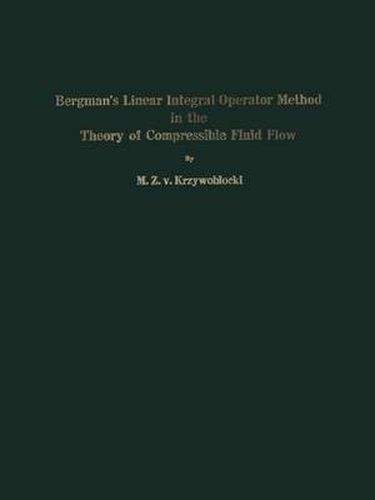Readings Newsletter
Become a Readings Member to make your shopping experience even easier.
Sign in or sign up for free!
You’re not far away from qualifying for FREE standard shipping within Australia
You’ve qualified for FREE standard shipping within Australia
The cart is loading…






This title is printed to order. This book may have been self-published. If so, we cannot guarantee the quality of the content. In the main most books will have gone through the editing process however some may not. We therefore suggest that you be aware of this before ordering this book. If in doubt check either the author or publisher’s details as we are unable to accept any returns unless they are faulty. Please contact us if you have any questions.
The reader who is somewhat acquainted with the field of compressible fluid flow hears much about Stefan Bergman’s method of integral operators. It took many years for him to develop this method which is based primarily on the theory of analytic functions and particularly on the theory of)functions of two complex variables. The method, as a whole, is scattered throughout many papers in mathematical journals, and as a matter of fact, in its present state, is accessible only to those who are fully acquainted with mathematical literature. In one of their papers, Professors R. von Mises and M. Schiffer greatly simplified the method in the subsonic casco The purpose of the present work is to represent the method in all its variations in such a way that a theoretical engineer or an applied aerodynamicist can use it in practical applications. A professional mathematician will find the discussion too elementary for him. The parts of Bergman’s presentation which are most interesting mathe- matically-the proofs-are mostly omitted in the present work. The emphasis was put upon the simplified representation of the final results and formulas, rather than upon the derivation of those formulas. In the preliminary remarks the author discusses various types of singularities in a very elementary way. The first two parts of the work deal with the subsonic case. In these sections the author followed mostly the paper of von Mises and Schiffer.
$9.00 standard shipping within Australia
FREE standard shipping within Australia for orders over $100.00
Express & International shipping calculated at checkout
This title is printed to order. This book may have been self-published. If so, we cannot guarantee the quality of the content. In the main most books will have gone through the editing process however some may not. We therefore suggest that you be aware of this before ordering this book. If in doubt check either the author or publisher’s details as we are unable to accept any returns unless they are faulty. Please contact us if you have any questions.
The reader who is somewhat acquainted with the field of compressible fluid flow hears much about Stefan Bergman’s method of integral operators. It took many years for him to develop this method which is based primarily on the theory of analytic functions and particularly on the theory of)functions of two complex variables. The method, as a whole, is scattered throughout many papers in mathematical journals, and as a matter of fact, in its present state, is accessible only to those who are fully acquainted with mathematical literature. In one of their papers, Professors R. von Mises and M. Schiffer greatly simplified the method in the subsonic casco The purpose of the present work is to represent the method in all its variations in such a way that a theoretical engineer or an applied aerodynamicist can use it in practical applications. A professional mathematician will find the discussion too elementary for him. The parts of Bergman’s presentation which are most interesting mathe- matically-the proofs-are mostly omitted in the present work. The emphasis was put upon the simplified representation of the final results and formulas, rather than upon the derivation of those formulas. In the preliminary remarks the author discusses various types of singularities in a very elementary way. The first two parts of the work deal with the subsonic case. In these sections the author followed mostly the paper of von Mises and Schiffer.